Judith A. Yates's Blog, page 5
January 23, 2020
Serial killer Released From Prison, Killer’s Home Was On Market
A notorious serial killer just walked out of prison. The house where they planned the murders was up for sale two years before her release. It is all part of a tragedy that left nursing home residents dead, and many people’s lives shattered forever.Catherine Wood walked out of the minimum-security prison in Tallahassee, Florida, on January 16, 2020, after serving close to 30 years for taking part in the murder of at least five nursing home residents. The victims, aged 65 to 97, lay helpless in their beds while Wood and her lover, Gwen Graham, smothered them. Because of the age and physical condition of the patents, their deaths were
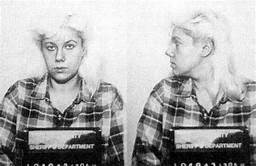 Cathy Wood mugshot 1988not suspicious. Then Wood initially confessed to her ex-husband, who went to the police. When investigators spoke with Wood, she admitted it was true, that she and Graham had systematically, coldly took the lives of helpless people who struggled to live; the last thing they saw was the smirking faces of Cathy Wood or Gwen Graham.
Cathy Wood mugshot 1988not suspicious. Then Wood initially confessed to her ex-husband, who went to the police. When investigators spoke with Wood, she admitted it was true, that she and Graham had systematically, coldly took the lives of helpless people who struggled to live; the last thing they saw was the smirking faces of Cathy Wood or Gwen Graham.
The killers lived in a 526 square foot house on Effie Lane. It has been remodeled. Still, there is the living room where Cathy and her work friends played many drinking games, and Cathy lorded over her coworkers with manipulation and abusive behavior. There is the bedroom where Wood and Graham kept souvenirs of the deceased, where they included smothering in sex play – the same type of smothering used to kill patients. Many fistfights, screaming, and drunken melees took place in the driveway and front yard. And all of the planning to kill innocent, helpless people happened in this house; Cathy Wood would later say of the murders “it was fun.” (Cauffiel, 2014).
Catherine May Wood (b.1962) met Gwendolyn Gail Graham (b. 1963) when the two worked together in 1986 as nurse’s aides at Alpine Manor Nursing Home in Grand Rapids, Michigan. They became lovers, Graham moving in at Cathy’s home on Effie Street in Grand Rapids. Wood had a reputation for stirring up trouble, keeping coworkers in constant drama, with fights, love triangles, and playing “mind games.” There were “jokes” and pranks at work that went unpunished: switching patients in their rooms, hiding under patients’ beds to scare each other, slipping in and out of places via windows, coworkers meeting for sex, and coming to work intoxicated. Wood was also physically and The house where the planning took placeemotionally abusive to her ex-husband and Graham, and when interviewed by law enforcement after the murders, admitted to child abuse, elderly abuse, murder, and more.
The house where the planning took placeemotionally abusive to her ex-husband and Graham, and when interviewed by law enforcement after the murders, admitted to child abuse, elderly abuse, murder, and more.
Cathy Wood’s excuses for the killing varied. The murders began as a “game” between Wood and Graham; they were killing specific patients, so the victim’s initials spelled MURDER. Then it was to forever bond the two lovers in a “secret pact.” Later, Wood told others it was she who killed, and she blamed Graham to get revenge. But the only two people who know the truth are Wood and Graham. Wood, being a classic narcissist and sociopath, is a practiced liar. All information about the murders came from her; otherwise, there was no real evidence. Graham never admitted guilt.Graham would be found guilty of five counts of murder and one count of conspiracy to commit murder in 1989 and is serving five life sentences in state prison. For testifying against Graham and for cooperating with authorities, Wood was arrested in 1988 and charged with one count of second-degree murder and one count of conspiracy to commit second-degree murder. She received 20 years on each count in a federal prison. She was denied parole each time she was eligible. Alpine Manor has changed companies and names several times since the tragedy. People of Grand Rapids still remember the horror. The victim’s loved ones will never recover. The house on Effie has new owners. And Cathy Wood has a new life, thanks to a bureaucracy that allowed a sociopath to make a slick deal, ensuring her release into the world she destroyed for innocent people.
New York Times Best Selling Author Lowell Cauffiel’s “Forever And Five Days” details the case in depth. Read a sample and purchase the book HERE.
Thanks to Ryan Matthews for providing information.
 Cathy Wood mugshot 1988not suspicious. Then Wood initially confessed to her ex-husband, who went to the police. When investigators spoke with Wood, she admitted it was true, that she and Graham had systematically, coldly took the lives of helpless people who struggled to live; the last thing they saw was the smirking faces of Cathy Wood or Gwen Graham.
Cathy Wood mugshot 1988not suspicious. Then Wood initially confessed to her ex-husband, who went to the police. When investigators spoke with Wood, she admitted it was true, that she and Graham had systematically, coldly took the lives of helpless people who struggled to live; the last thing they saw was the smirking faces of Cathy Wood or Gwen Graham.The killers lived in a 526 square foot house on Effie Lane. It has been remodeled. Still, there is the living room where Cathy and her work friends played many drinking games, and Cathy lorded over her coworkers with manipulation and abusive behavior. There is the bedroom where Wood and Graham kept souvenirs of the deceased, where they included smothering in sex play – the same type of smothering used to kill patients. Many fistfights, screaming, and drunken melees took place in the driveway and front yard. And all of the planning to kill innocent, helpless people happened in this house; Cathy Wood would later say of the murders “it was fun.” (Cauffiel, 2014).
Catherine May Wood (b.1962) met Gwendolyn Gail Graham (b. 1963) when the two worked together in 1986 as nurse’s aides at Alpine Manor Nursing Home in Grand Rapids, Michigan. They became lovers, Graham moving in at Cathy’s home on Effie Street in Grand Rapids. Wood had a reputation for stirring up trouble, keeping coworkers in constant drama, with fights, love triangles, and playing “mind games.” There were “jokes” and pranks at work that went unpunished: switching patients in their rooms, hiding under patients’ beds to scare each other, slipping in and out of places via windows, coworkers meeting for sex, and coming to work intoxicated. Wood was also physically and
 The house where the planning took placeemotionally abusive to her ex-husband and Graham, and when interviewed by law enforcement after the murders, admitted to child abuse, elderly abuse, murder, and more.
The house where the planning took placeemotionally abusive to her ex-husband and Graham, and when interviewed by law enforcement after the murders, admitted to child abuse, elderly abuse, murder, and more.Cathy Wood’s excuses for the killing varied. The murders began as a “game” between Wood and Graham; they were killing specific patients, so the victim’s initials spelled MURDER. Then it was to forever bond the two lovers in a “secret pact.” Later, Wood told others it was she who killed, and she blamed Graham to get revenge. But the only two people who know the truth are Wood and Graham. Wood, being a classic narcissist and sociopath, is a practiced liar. All information about the murders came from her; otherwise, there was no real evidence. Graham never admitted guilt.Graham would be found guilty of five counts of murder and one count of conspiracy to commit murder in 1989 and is serving five life sentences in state prison. For testifying against Graham and for cooperating with authorities, Wood was arrested in 1988 and charged with one count of second-degree murder and one count of conspiracy to commit second-degree murder. She received 20 years on each count in a federal prison. She was denied parole each time she was eligible. Alpine Manor has changed companies and names several times since the tragedy. People of Grand Rapids still remember the horror. The victim’s loved ones will never recover. The house on Effie has new owners. And Cathy Wood has a new life, thanks to a bureaucracy that allowed a sociopath to make a slick deal, ensuring her release into the world she destroyed for innocent people.
New York Times Best Selling Author Lowell Cauffiel’s “Forever And Five Days” details the case in depth. Read a sample and purchase the book HERE.
Thanks to Ryan Matthews for providing information.
Published on January 23, 2020 17:39
January 20, 2020
This Female Serial Killer Had Over 2,000 Victims
The woman stepping out of the building was probably staying in the shadows, covering her head and ducking away quickly. She had a reason to be secretive: she had just left the dwelling of Catherine Monvoisin, (Montvoisin?) DeShay, a sorcerer and fortune-teller who provided abortions, but now dealt in providing poisons. The woman sneaking off was a client who would be murdering one of DeShay's alleged 2,500 victims.It was in the mid-1600s in Paris, France. Catherine DeShay, born around 1640, had married a merchant named Antoine Monvoisin (sometimes spelled Montvoisin). When Antoine's business collapsed, Catherine began making a living as a
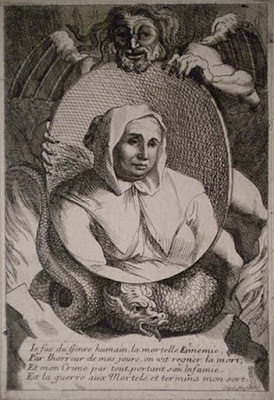 17th century print of Catherine DeShay
17th century print of Catherine DeShay
fortune teller, "reading faces," and palmistry. She had a "gift from God," she would say, having told fortunes from the age of nine. "Eventually, these gifts led her to become one of the most mystical and fascinating people in the second half of the 17th century Paris" (Klimczak). She was also a midwife, which included performing abortions. Catherine became "La Voisin" ("the neighbor"). While telling fortunes, she found there was a market for potions, aphrodisiacs, black masses, magical amulets, and poisons. She dressed for success in a red robe embroidered with eagles in gold thread. As La Voisin's business prospered, her client list became more impressive. Nobility flocked to her, all wanting to know what their future held. And they wanted to purchase poisons to alter that future, should it need a little help.
La Voisin's clients were upper-class citizens, for La Voisin's prices were not cheap. Most came to eliminate a husband, as many clients were female, or a competitor be it political or amorous. This included the official mistress of King Louis XIV, Madame de Montespan, who initially purchased love potions and spells to woo the king. When his interest in Montespan waned and then dissipated, Montespan conspired with La Voisin and several others to poison the king. There was a mishap, and the king's life was spared, unbeknownst to anyone except the conspirators.La Voisin was so successful she branched out by creating a network of fortune-tellers throughout Paris, including one of her daughters. La Voisin took up residency at the Villeneuve-sur-Gravois. By day she sold her wares and doled out futures. By night the famous clairvoyant entertained the privileged upper class with parties and music in her lush garden. It was common knowledge she was a drunkard, but she was also a trusted source for all things black magic and the go-to person if you wanted to get rid of someone permanently. And she was no slouch. "La Voisin regularly attended service at the church of the Jansenist abbé de Sant-Amour, principal of the Paris University, and the godmother of her daughter was the noblewoman Mme de la Roche-Guyon" (Ramsland). La Voisin supported her mother, husband Antoine, and their four children, and as many as at least six paramours, with her wealth. She grew to hate her husband; she usually greeted him with, "Have you dropped dead yet?"(Somerset) She visited the royal court, the homes of the royals and wealthy, and houses of worship to perform her ceremonies and sell her wares. Some priests took part in the black masses. La Voisin is suspected of causing at least 2,500 deaths. These victims would be the number of people who died from poisoning, ingesting the potion she had sold. There were also babies murdered during sacrifices for the black masses. Serial killer expert Peter Vronsky lists La Voisin as a serial killer. But a royal death, public persecution, and religion were to be the downfall of La Voisin. First, the Duchesse d'Orléans, sister-in-law to Louis XIV, died; her death believed to be poison (in truth, it was gastroenteritis). Then there was a riot of people accusing witches of stealing children for use in black mass. Next, priests came forth to add that people were confessing to using poisons. There was a sweep of the city to arrest anyone practicing "witchcraft." La Voisin, well known for her profession, was arrested on March 12, 1679."Paris is full of this kind of thing, and there is an infinite number of people engaged in this evil trade," La Voisin told her interrogators. The persons interviewing her received permission to torture their arrestees, but not La Voisin, because she would start naming names that would embarrass many in the aristocracy and members of the royal court. So the interviewers kept her drunk and let her chatter instead. On October 10, a drunk La Voisin admitted she did sell "poison and magical services to several members of the royal court; she also described the development of her career." She denied taking part in black masses and performing abortions, said nothing of her role in Madame de Montespan's plot to murder the king.The criminal case was a sensation. The "Affair of the Poisons" of 1679 was akin to the O.J. Simpson murder trial of 1995 in public interest. It "implicated persons at the highest levels of French government and nobility"(Klimczak). The trial began on February 17, 1680, and lasted two days. In the end, thirty-six death sentences were handed down. Only La Voisin was burned at the stake on February 22, 1680; the other thirty-five were sent to prison. Records reveal that on her way to the burn pyre, La Voisin shoved the priest away. Tied to the stake, she feebly attempted to kick away the hay. It was, of course, in vain. And none of her once-loyal customers, who only days ago held her in high esteem, came rushing to her aid. She died a "witch" burning alive.
ResourcesThe Brooklyn MuseumElizabeth A. Sackler Center for Feminist Art, Heritage FloorOnline resource located at https://www.brooklynmuseum.org/eascfa..., N. (November 5, 2016). The Black Masses of La Voisin: How A Fortune Teller Became A Murderess in the French Royal Court.Ramsland, K. (2005). The Human Predator. The Berkley Publishing Group: New York CitySomerset, A. (2003) The Affair of the Poisons: Murder, Infanticide, and Satanism at the Court of Louis XIV. St. Martin's Press: New York City.Vronsky, P. (2007) Female Serial Killers. The Penguin Group: New York.
 17th century print of Catherine DeShay
17th century print of Catherine DeShayfortune teller, "reading faces," and palmistry. She had a "gift from God," she would say, having told fortunes from the age of nine. "Eventually, these gifts led her to become one of the most mystical and fascinating people in the second half of the 17th century Paris" (Klimczak). She was also a midwife, which included performing abortions. Catherine became "La Voisin" ("the neighbor"). While telling fortunes, she found there was a market for potions, aphrodisiacs, black masses, magical amulets, and poisons. She dressed for success in a red robe embroidered with eagles in gold thread. As La Voisin's business prospered, her client list became more impressive. Nobility flocked to her, all wanting to know what their future held. And they wanted to purchase poisons to alter that future, should it need a little help.
La Voisin's clients were upper-class citizens, for La Voisin's prices were not cheap. Most came to eliminate a husband, as many clients were female, or a competitor be it political or amorous. This included the official mistress of King Louis XIV, Madame de Montespan, who initially purchased love potions and spells to woo the king. When his interest in Montespan waned and then dissipated, Montespan conspired with La Voisin and several others to poison the king. There was a mishap, and the king's life was spared, unbeknownst to anyone except the conspirators.La Voisin was so successful she branched out by creating a network of fortune-tellers throughout Paris, including one of her daughters. La Voisin took up residency at the Villeneuve-sur-Gravois. By day she sold her wares and doled out futures. By night the famous clairvoyant entertained the privileged upper class with parties and music in her lush garden. It was common knowledge she was a drunkard, but she was also a trusted source for all things black magic and the go-to person if you wanted to get rid of someone permanently. And she was no slouch. "La Voisin regularly attended service at the church of the Jansenist abbé de Sant-Amour, principal of the Paris University, and the godmother of her daughter was the noblewoman Mme de la Roche-Guyon" (Ramsland). La Voisin supported her mother, husband Antoine, and their four children, and as many as at least six paramours, with her wealth. She grew to hate her husband; she usually greeted him with, "Have you dropped dead yet?"(Somerset) She visited the royal court, the homes of the royals and wealthy, and houses of worship to perform her ceremonies and sell her wares. Some priests took part in the black masses. La Voisin is suspected of causing at least 2,500 deaths. These victims would be the number of people who died from poisoning, ingesting the potion she had sold. There were also babies murdered during sacrifices for the black masses. Serial killer expert Peter Vronsky lists La Voisin as a serial killer. But a royal death, public persecution, and religion were to be the downfall of La Voisin. First, the Duchesse d'Orléans, sister-in-law to Louis XIV, died; her death believed to be poison (in truth, it was gastroenteritis). Then there was a riot of people accusing witches of stealing children for use in black mass. Next, priests came forth to add that people were confessing to using poisons. There was a sweep of the city to arrest anyone practicing "witchcraft." La Voisin, well known for her profession, was arrested on March 12, 1679."Paris is full of this kind of thing, and there is an infinite number of people engaged in this evil trade," La Voisin told her interrogators. The persons interviewing her received permission to torture their arrestees, but not La Voisin, because she would start naming names that would embarrass many in the aristocracy and members of the royal court. So the interviewers kept her drunk and let her chatter instead. On October 10, a drunk La Voisin admitted she did sell "poison and magical services to several members of the royal court; she also described the development of her career." She denied taking part in black masses and performing abortions, said nothing of her role in Madame de Montespan's plot to murder the king.The criminal case was a sensation. The "Affair of the Poisons" of 1679 was akin to the O.J. Simpson murder trial of 1995 in public interest. It "implicated persons at the highest levels of French government and nobility"(Klimczak). The trial began on February 17, 1680, and lasted two days. In the end, thirty-six death sentences were handed down. Only La Voisin was burned at the stake on February 22, 1680; the other thirty-five were sent to prison. Records reveal that on her way to the burn pyre, La Voisin shoved the priest away. Tied to the stake, she feebly attempted to kick away the hay. It was, of course, in vain. And none of her once-loyal customers, who only days ago held her in high esteem, came rushing to her aid. She died a "witch" burning alive.
ResourcesThe Brooklyn MuseumElizabeth A. Sackler Center for Feminist Art, Heritage FloorOnline resource located at https://www.brooklynmuseum.org/eascfa..., N. (November 5, 2016). The Black Masses of La Voisin: How A Fortune Teller Became A Murderess in the French Royal Court.Ramsland, K. (2005). The Human Predator. The Berkley Publishing Group: New York CitySomerset, A. (2003) The Affair of the Poisons: Murder, Infanticide, and Satanism at the Court of Louis XIV. St. Martin's Press: New York City.Vronsky, P. (2007) Female Serial Killers. The Penguin Group: New York.
Published on January 20, 2020 03:15
January 13, 2020
Not So Strange Twins: June and Jennifer Gibbons
They have been labeled strange, though their life story is true. June and Jennifer Gibbons were two creative and insightful identical twins whose lives were both an enigma and a mystery to everyone except themselves. Their vow of silence led to a life of crime and, eventually, lifelong hospitalization in part because of their silence. They were the daughters of Caribbean immigrants Gloria and Aubrey Gibbons. Aubrey was in the Royal Air Force, so the family moved often. The twins were born in Yemen in 1963; the family moved to England, and finally to Wales.
 June and Jennifer Gibbons: more
June and Jennifer Gibbons: more
misunderstood than "strange" little twinsFrom childhood, both twins had a slight speech impediment. Also, the girls spoke Bajan Creole. Not many could understand them. Because they learned there is strength in numbers, they were inseparable. June would later explain they grew weary of people asking them, "what did you say?" so often that they just chose to "not speak at all" in public. So June and Jennifer created their own communication, which included body language and eye contact. Over time June and Jennifer Gibbons became mirror images of one another, yet secretly penned in journals how they yearned to be an individual. Being the only black students in the Wales elementary school, and speaking a language few could understand, they endured bullying and harassment from students until a teacher decided it best to allow the girls to leave class early to walk home alone. Perhaps this did more harm than the intended good. Sometimes it felt the school staff was racist. So June and Jennifer closed off from both students and staff. The twins refused to read. They would not write. They went before a succession of psychologists and specialists but remained silent. Separating them only caused them to become catatonic, near zombies. Their silence in class baffled and angered those in the school system. Finally, at a loss, doctors sent the girls to an alternative school.June and Jennifer were admitted to the specialized school where clandestine video was taken of them as they worked with instructors and ate meals in the dining hall. Teachers worked with the girls as if the twins had learning disorders. The twins ate and moved very slow, were always last to leave their seats, and students moved around them as if June and Jennifer were nonexistent. Or were the girls purposely erasing themselves to avoid attention? When no one else was in the room, the twins spoke freely in what sounded like gibberish to one another. Yet when the audiotape was slowed, it was clear the twins spoke perfect English, just at a rapid-fire pace no one else could understand. Eventually, the twins gave up on education, and the education system gave up on the girls. Better to not have to deal with these strange little girls than to continually have the disruptions and problems. The twins became homebound, drawing government checks. At home, June and Jennifer secreted themselves in their bedroom. Their family, to include most siblings and both parents, allowed the girls to isolate themselves from everyone, to include holidays. Their stoic father was non-communicable, and their mother vacillated between making excuses and practicing a laissez-faire attitude. Their siblings lived healthy lives. Their parents made excuses for the twins, calling them "shy." The twins just avoided family interaction, preferring one another's company their entire life at home.But it was not a wholly silent world. June and Jennifer shared a room with a younger sister, Rosie, and played with her, including the creation of detailed, intricate games with dolls. The three talked and played, recording the games on audiotape. Rosie remembers her sisters as fun and the games as being happy and exciting. Both girls were writers at heart, and it is a shame no one got to read their work until a biography was released, "The Silent Twins" by Marjorie Wallace (1987). This book's photos include the writing and artwork of the twins. June and Jennifer used a correspondence course in creative writing. Their fiction was witty with an element of criminal activity. They published using vanity presses (today called print-on-demand). When the twins needed an album or correspondence course, they wrote out their orders to slip under their bedroom door, where their mother would dutifully collect the slips of paper and have the item delivered. As close as they were, the girls feared one another. They would each attempt to murder the other by strangulation and drowning. Both June and Jennifer journaled their fear of the other. Soon, the outside world became a curiosity. June and Jennifer Gibbons used binoculars to watch the neighborhood goings-on from their bedroom window. They sent away for a correspondence course "How To Communicate," but June says they were far too shy to even begin the first lessons. The twins were growing into their teen years. Soon the bedroom was stifling. It was time to see the world. June and Jennifer eventually left the house. They managed to keep their code of silence while discovering alcohol, boys, sex, drugs, shoplifting, and breaking into homes, and began to imbibe in all. When petty crimes grew boring, the twins began to set fires. It was arson that led them to appear before a judge. In 1981, a judge sentenced them to the high-security Broadmore Hospital for an indefinite term, in part based on their strange, silent behavior. June would complain later, "Juvenile delinquents get two years in prison. We got twelve years of hell because we didn't speak. We lost hope, really. We were trapped."So the twins continued their silent existence while serving life in this hospital built for the criminally insane. Pulled apart, they again became comatose and zombie-like, refusing to speak or even look at staff, visitors, or fellow inmates. But when together, they complained of the other, competitive, and fighting to the point of bloodshed, desperate to be individuals. The twins had made a pact that upon one's death, the other would lead a speaking, "normal" life. In Broadmore, the subject surfaced, and they decided one should die. Jennifer volunteered to be that martyr. The twins were released to a lower security facility in 1993. En route, Jennifer died suddenly of strange circumstances; officially, it was "inflammation of the heart," yet toxicology revealed no drugs, and she was a healthy woman. June was released a year later and lived a lonely sole existence. She visited Jennifer's grave often, and read the inscription on Jennifer's headstone, a poem by June:We once were twoWe two made oneWe no more twoThrough life be oneRest in peace.June would later give interviews about her life as one of the "silent Gibbons twins." Initially, she is challenging to understand, as she still has a speech impediment and strong dialect. Her story is fascinating and breaks many of the myths built up for so long around these interesting twins. But she is finally speaking. And people are finally listening.
Resources:Als, Hilton. (December 4, 2000). The New Yorker.Silent Twins: Without My Shadow (November 20, 2017). Lichtenstein, O. Writer, Director. BBC: Worldwide Ltd. Wallace, M. (October 12, 1987) "The Silent Twins." Ballantine Books.
 June and Jennifer Gibbons: more
June and Jennifer Gibbons: more misunderstood than "strange" little twinsFrom childhood, both twins had a slight speech impediment. Also, the girls spoke Bajan Creole. Not many could understand them. Because they learned there is strength in numbers, they were inseparable. June would later explain they grew weary of people asking them, "what did you say?" so often that they just chose to "not speak at all" in public. So June and Jennifer created their own communication, which included body language and eye contact. Over time June and Jennifer Gibbons became mirror images of one another, yet secretly penned in journals how they yearned to be an individual. Being the only black students in the Wales elementary school, and speaking a language few could understand, they endured bullying and harassment from students until a teacher decided it best to allow the girls to leave class early to walk home alone. Perhaps this did more harm than the intended good. Sometimes it felt the school staff was racist. So June and Jennifer closed off from both students and staff. The twins refused to read. They would not write. They went before a succession of psychologists and specialists but remained silent. Separating them only caused them to become catatonic, near zombies. Their silence in class baffled and angered those in the school system. Finally, at a loss, doctors sent the girls to an alternative school.June and Jennifer were admitted to the specialized school where clandestine video was taken of them as they worked with instructors and ate meals in the dining hall. Teachers worked with the girls as if the twins had learning disorders. The twins ate and moved very slow, were always last to leave their seats, and students moved around them as if June and Jennifer were nonexistent. Or were the girls purposely erasing themselves to avoid attention? When no one else was in the room, the twins spoke freely in what sounded like gibberish to one another. Yet when the audiotape was slowed, it was clear the twins spoke perfect English, just at a rapid-fire pace no one else could understand. Eventually, the twins gave up on education, and the education system gave up on the girls. Better to not have to deal with these strange little girls than to continually have the disruptions and problems. The twins became homebound, drawing government checks. At home, June and Jennifer secreted themselves in their bedroom. Their family, to include most siblings and both parents, allowed the girls to isolate themselves from everyone, to include holidays. Their stoic father was non-communicable, and their mother vacillated between making excuses and practicing a laissez-faire attitude. Their siblings lived healthy lives. Their parents made excuses for the twins, calling them "shy." The twins just avoided family interaction, preferring one another's company their entire life at home.But it was not a wholly silent world. June and Jennifer shared a room with a younger sister, Rosie, and played with her, including the creation of detailed, intricate games with dolls. The three talked and played, recording the games on audiotape. Rosie remembers her sisters as fun and the games as being happy and exciting. Both girls were writers at heart, and it is a shame no one got to read their work until a biography was released, "The Silent Twins" by Marjorie Wallace (1987). This book's photos include the writing and artwork of the twins. June and Jennifer used a correspondence course in creative writing. Their fiction was witty with an element of criminal activity. They published using vanity presses (today called print-on-demand). When the twins needed an album or correspondence course, they wrote out their orders to slip under their bedroom door, where their mother would dutifully collect the slips of paper and have the item delivered. As close as they were, the girls feared one another. They would each attempt to murder the other by strangulation and drowning. Both June and Jennifer journaled their fear of the other. Soon, the outside world became a curiosity. June and Jennifer Gibbons used binoculars to watch the neighborhood goings-on from their bedroom window. They sent away for a correspondence course "How To Communicate," but June says they were far too shy to even begin the first lessons. The twins were growing into their teen years. Soon the bedroom was stifling. It was time to see the world. June and Jennifer eventually left the house. They managed to keep their code of silence while discovering alcohol, boys, sex, drugs, shoplifting, and breaking into homes, and began to imbibe in all. When petty crimes grew boring, the twins began to set fires. It was arson that led them to appear before a judge. In 1981, a judge sentenced them to the high-security Broadmore Hospital for an indefinite term, in part based on their strange, silent behavior. June would complain later, "Juvenile delinquents get two years in prison. We got twelve years of hell because we didn't speak. We lost hope, really. We were trapped."So the twins continued their silent existence while serving life in this hospital built for the criminally insane. Pulled apart, they again became comatose and zombie-like, refusing to speak or even look at staff, visitors, or fellow inmates. But when together, they complained of the other, competitive, and fighting to the point of bloodshed, desperate to be individuals. The twins had made a pact that upon one's death, the other would lead a speaking, "normal" life. In Broadmore, the subject surfaced, and they decided one should die. Jennifer volunteered to be that martyr. The twins were released to a lower security facility in 1993. En route, Jennifer died suddenly of strange circumstances; officially, it was "inflammation of the heart," yet toxicology revealed no drugs, and she was a healthy woman. June was released a year later and lived a lonely sole existence. She visited Jennifer's grave often, and read the inscription on Jennifer's headstone, a poem by June:We once were twoWe two made oneWe no more twoThrough life be oneRest in peace.June would later give interviews about her life as one of the "silent Gibbons twins." Initially, she is challenging to understand, as she still has a speech impediment and strong dialect. Her story is fascinating and breaks many of the myths built up for so long around these interesting twins. But she is finally speaking. And people are finally listening.
Resources:Als, Hilton. (December 4, 2000). The New Yorker.Silent Twins: Without My Shadow (November 20, 2017). Lichtenstein, O. Writer, Director. BBC: Worldwide Ltd. Wallace, M. (October 12, 1987) "The Silent Twins." Ballantine Books.
Published on January 13, 2020 14:00
January 5, 2020
ChoiceCenter Leadership University – Cult or Self Help? One investigator shares experience
According to its website, ChoiceCenter Leadership University has offered "... personal development and leadership courses using experiential learning to elevate Emotional Intelligence (E.Q.)." One investigator that attended the university says it is a cult in the guise of a university – and explains, in detail, what "experiential learning" was in her course.The investigator, Jill,* recently attended the Las Vegas-based school. A friend paid her $2,700 entry fee the ChoiceCenter course,"** a 100-day training. From the moment she walked into the windowless training room with 100 participants, the Star Wars theme song blasting, to the graduation, Jill describes her experience as "frightening, exhausting, and cult-like." Video cameras in the room recorded every move. A panel of "coaches" sat in the back of the room to evaluate students. Jill's formal education includes psychology, criminology, and work as an investigator, so she took careful notice of the program's curriculum. Rules included "no drug use, no smoking, no drinking, no sex, no gambling, and no entering into a new relationship until 30 days after the training." Men had to shave all facial hair. Next, participants "had to walk up to all strangers and say 1. I trust you, 2. I don't trust you, or 3. I don't know yet," Jill explains. Participants had to announce secrets; some recounted horrific child abuse and sexual assault. Others had severe family issues. There were no professional therapists, counselors, or doctors to assist these trauma survivors during the course.Jill recalls staff telling the participants, "We are your family and friends for life, and we love you ... we'll always love you." If students wanted to quit, "coaches and participants would encircle the quitter (as a group) and beg them to stay."
 www.choicecenter.comThere seems to be much screaming involved in "experiential learning." Exercises included "stand(ing) and screaming at the top of your lungs… (And) another exercise where two students nose to nose taking turns screaming,' What do you want!'" Repeatedly at one another. In one session, "'Feedback arch,' one person stands in front of a group, and the person gets screamed at (about) 'what is wrong' with them … Then you move from one group to the next" for continued verbal abuse. Coaches assist and encourage the screaming.Jill describes the participants, including herself, "sleep-deprived, starving, dehydrated, and covered in sweat." She explains, "Temperatures in the room were changed drastically." Lights went from dim to bright, and music blasted at intervals, all of it purposely. During the breaks, students were to keep "a vow of silence." Jill says the program involved sleep and food deprivation. Courses would end at 1:00 am, then copious amounts of homework had to be completed, the usual bathing and prepping for the next day, and mandatory attendance resumed at about 10:00 am for the emotionally and physically drained participants. Participants were allowed to purchase and bring their drinks and light snacks, but only water was allowed in the training room. Being "allowed" to go to dinner but only in their "power groups" included a ChoiceCenter coach. "Constructive criticism" was always part of dinner, each person required to tell the other, "'how you show up to me is….' Then you had to say something negative," Jill explains. Jill did experience some positive experiences like the "hug line" where all of the classes met to give one another a hug and positive reinforcement. "It felt good after being torn down repeatedly.” Part Two of the course is "Breakthrough," and "Breakthrough differed from discovery ... the psychological, physical, mental, and emotional abuse is much, much greater." Jill recalls shortened breaks; food, water, and sleep deprivation intensified. "Only this time, they are going to verbally abuse (participants)." An exercise called "Lifeboat" had participants lying on the floor in a darkened room. Jill describes this exercise as
www.choicecenter.comThere seems to be much screaming involved in "experiential learning." Exercises included "stand(ing) and screaming at the top of your lungs… (And) another exercise where two students nose to nose taking turns screaming,' What do you want!'" Repeatedly at one another. In one session, "'Feedback arch,' one person stands in front of a group, and the person gets screamed at (about) 'what is wrong' with them … Then you move from one group to the next" for continued verbal abuse. Coaches assist and encourage the screaming.Jill describes the participants, including herself, "sleep-deprived, starving, dehydrated, and covered in sweat." She explains, "Temperatures in the room were changed drastically." Lights went from dim to bright, and music blasted at intervals, all of it purposely. During the breaks, students were to keep "a vow of silence." Jill says the program involved sleep and food deprivation. Courses would end at 1:00 am, then copious amounts of homework had to be completed, the usual bathing and prepping for the next day, and mandatory attendance resumed at about 10:00 am for the emotionally and physically drained participants. Participants were allowed to purchase and bring their drinks and light snacks, but only water was allowed in the training room. Being "allowed" to go to dinner but only in their "power groups" included a ChoiceCenter coach. "Constructive criticism" was always part of dinner, each person required to tell the other, "'how you show up to me is….' Then you had to say something negative," Jill explains. Jill did experience some positive experiences like the "hug line" where all of the classes met to give one another a hug and positive reinforcement. "It felt good after being torn down repeatedly.” Part Two of the course is "Breakthrough," and "Breakthrough differed from discovery ... the psychological, physical, mental, and emotional abuse is much, much greater." Jill recalls shortened breaks; food, water, and sleep deprivation intensified. "Only this time, they are going to verbally abuse (participants)." An exercise called "Lifeboat" had participants lying on the floor in a darkened room. Jill describes this exercise as(The trainer tells you to) visualize being in a boat, it's sinking, we're all going to die, and we are never going to see or talk to our friends and family again. What haven't we said? What haven't we done? But … there's one lifeboat, and six people get to live. We had to go to the microphone and say why we should live, and plead and beg for our lives. (The trainer) gave 15 minutes … for all of us to strategize how we pick the six people who survive. We had to stand in a huge circle (and) give six popsicles sticks to give the six (of 100) people we deem as worthy of living. We have three options as we go up to every single person: 1. Say the person's name, and they live 2. Say the person's name, and they don't live, or 3. Say, verbatim, "I don't know your name, I don't care about you, and you don't live."
No one was allowed to touch. Coaches followed each student, "screaming at the person… like—"They don't even know your name! You're invisible! How do you show up in your life? Dead to the world?" To the person handing out the sticks: "You don't even bother to know their name? What is wrong with you? How many people in your life do you neglect! Imagine that's your (family member). You're letting your family drown!"
One of the "Stretch" exercises cast each female participant as a famous singer. They had two hours to drive around in Las Vegas in groups of six searching and purchasing clothing ("sexy" the coach suggested), learn dance moves, and eat dinner. Attractive males were divided into two groups ("L.M.F.A.O." and "Magic Mikes") and were told, "You boys are going to strip!" Removing all clothing except underwear. "Big, tough" males had to wear tutus and dance. They all performed for one another. "Leadership" class consisted of participants telephoning friends and family to enroll five people for ChoiceCenter courses. According to ChoiceCenter's website, "ChoiceCenter has existed without running advertisements or commercials or providing incentives to graduates. Our students experience such powerful results in their lives that they want to pay the experience forward and share it with those they love." According to Jill, participants were given a “hard sell” script to use. To graduate the course, it was mandatory the participant enroll one person. Participants also had to "give back" by volunteering to clean the ChoiceCenter offices and bathrooms. In the portion "Legacy," classes are given one week to raise $130,000 to a charity selected by ChoiceCenter, given in the name of ChoiceCenter. Bottom line: ChoiceCenter has free sales calls, free office janitorial services, and a tax break - all managed by free labor. Jill explains one reason why she and her friends stayed: Coaches continually promised the last weekend to be "a magical, wonderful time." On the last weekend, participants "discovered the truth." First, participants were given a list of mandatory items for a retreat; some total costs ran as high as $500. "Some of the stuff on the list was on there to throw you off; you didn't need it." Next, ChoiceCenter seized all makeup (including skincare), and electronics. Finally, drivers in black suits driving black S.U.V.s drove participants to an unknown destination with "vow of silence" in place. They arrived at a group of small mountain cabins with the heat purposely shut off; it was snowing heavily, and many students were not wearing appropriate cold-weather clothing, "so we were freezing." Bathing was not allowed. They were dropped off and left without phones, maps, or any way to return to civilization.While some students enjoyed their experience at ChoiceCenter Leadership University, Jill says she did not. Out of 100 participants, only 41 graduated, including Jill.Jill feels she made real friendships, and it was "adventurous" – akin to "going to war." She believes the reason people stayed in the program and followed the rules "was the lure of the last weekend retreat or the promise of networking and having a family with unconditional love" from ChoiceCenter's "family." Being told, "If you quit (the class), you'll lose friends and family" kept people, including Jill, from leaving. "I stayed because I didn't want to lose my friends." The promise of becoming a coach and "changing people's lives for the better" was also a lure (Jill later discovered coaches work for free, another “giving back” tactic). To become a coach only requires graduation from the training. Coaches told participants, "if '(we) discussed the training to anyone outside (we) had no integrity.' They made us feel like scumbags if we talked." However, Jill is talking. "I think it's about ChoiceCenter making money." She sighs deeply. "I feel like I did my time and escaped the place."
*For privacy purposes, pseudonyms are used** Name of course and dates not used here for privacy purposesChoiceCenter Leadership University website: www.choicecenter.com
Published on January 05, 2020 16:30
December 26, 2019
Survival Cannibalism: is it legal to kill someone for their flesh in order to survive?
Adrift in a lifeboat, after the ship sinks at sea, survival becomes visceral. Is killing someone justified if it aids others to stay alive by eating the dead's flesh? Or is it murder? "Survival cannibalism" after a shipwreck, abandoned at sea, became a "purported justification based on a custom of the sea" because of a landmark case in England, R v Dudley and Stephens (1884) 14 QBD 273 DC. In May 1884, the English yacht Mignonette left the docks of Southampton, sailing for Sydney, Australia. Onboard were Captain Tom Dudley, crew Edwin Stephens and Edmund Brooks, and a 17-year-old inexperienced cabin boy named Richard Parker. The yacht was a 52-foot cruiser, not made for high seas. But the only way to transport the ship to her new owner, John H. Want, was to sail the 15,000-mile voyage. Almost one month into the voyage, the Mignonette hit a storm about 1,600 miles northwest of the Cape of Good Hope. A wave took out a side of the boat, and she sank within five minutes. The crew hastily jumped into the thirteen-foot lifeboat, a flimsy canoe-style vessel of poor construction. They managed to save nautical navigation instruments and some
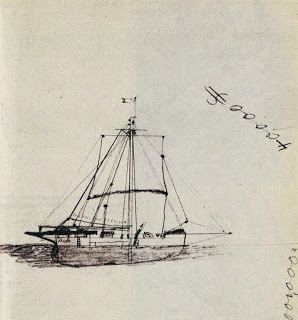
Photo: Sketch of English bark Mignonette by Tom
Dudley (1853-1900) as appeared in Simpson, A. W. B. turnips. Later they would catch and kill a turtle for food, but as their little boat bobbed and dipped in the currents, the men knew they would have to resort to desperate measures if they wanted to live. It was late July when the crew was at their lowest: they resorted to drinking urine and began discussed sacrificing a man for meat and blood. Richard Parker was ill and in a coma. Besides, he was an orphan and had no family. Dudley and Stephens murdered Parker and all of them began eating the flesh and drinking the blood to survive. Brooks did not agree to the killing, according to Brooks. Testimony would vary, but Brooks possibly ate little. On July 29, they were saved by a German sailing ship and taken to Falmouth, Cornwall. Per protocol, Dudley and Stephens reported into the customs house to enter statutory statements about their voyage, per Merchant Shipping Acts. It was here where Dudley and Stephens admitted their act of survival cannibalism. It was then the question arose: when charged with murder, is the "defense of necessity" allowed?Government entities could not agree on punishing the survivors; some thought arresting them with murder was wrong. Others believed the men morally and ethically wrong to kill to survive; they also labeled it as illegal despite public sentiment for the survivor. Supporters included Richard Parker's brother, also a seaman. The sole witnesses for the prosecution were the people who only heard of Parker's murder. On November 3, the trial began for murder, before Baron Huddleston, who had already made up his mind the two were guilty and intended to sway the jury into voting as such. "Huddleston presented (the jury) to find the men guilty of murder or return a special verdict. Without waiting for the jury's decision, Huddleston produced a special verdict that he had written the night before and invited the jury to indicate their assent to each paragraph as he read it out." (Simpson)The case was a legal mess; still, Tom Dudley and Edwin Stephens were found guilty and sentenced to the statutory death penalty with a recommendation for mercy. Queen Victoria could only exercise the latter, on the advice of the Home Secretary William Harcourt. Now that they were convicted, public opinion swayed against them. In early December, Harcourt decided to amend the sentence to six months. The men were released in May 1885. After being pardoned, Captain Tom Dudley and crew member Edwin Stephens disappeared into history, as did crew member Edmund Brooks. A plaque was erected in a churchyard in Peartree Green, Southampton, in memory of Richard Parker. There have been numerous cases of survival cannibalism. But England's cases R v Dudley and Stephens (1884) "established a precedent throughout the common law world that necessity is not a defense to a charge of murder." (Walker)
Resources
R v. Dudley and Stephens [1884] 14 QBD 273 DC.Simpson, A. W. B. (1984), "Cannibalism and the Common Law: The Story of the Tragic Last Voyage of the Mignonette and the Strange Legal Proceedings to Which It Gave Rise." Chicago: University of Chicago Press. "The Mignonette Case." (May 20, 1885) North-Eastern Daily Gazette: Britain. p. 4.Walker, A. (2011) "Is Eating People Wrong? Great Legal Cases and How They Shaped the World." New York: Cambridge Press.
Published on December 26, 2019 13:24
December 17, 2019
Serial killer Lawrence Bittaker dead; people using social media to express grief, requesting respect for sadistic murderer
Lawrence S. Bittaker was half of the serial killer duo known as “The Toolbox Killers” along with Roy L. Norris. Bittaker died from cancer on Friday, December 13, 2019, while incarcerated on San Quentin’s death row. His death is causing a social media frenzy, to include many people expressing grief over the death of this kidnapper,
 rapist, torturer, and murderer.
rapist, torturer, and murderer. Bittaker and Norris were dubbed the “Tool Box Killers” as they utilized a toolbox filled with hammers, ice picks, and pliers to torture and kill their victims. The serial killers murdered at least five innocent girls in a 1979 crime spree.
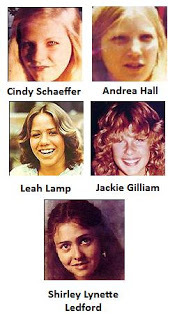 Bittaker and Norris, both career criminals, became friends while incarcerated at California Men’s Colony in San Luis Obispo. They shared their fantasies of kidnapping, torturing, and murdering girls. Upon release, they outfitted a van with sliding doors; naming it “Murder Mac” and set about making the sadistic fantasies come true. Bittaker and Norris jabbed ice picks into the ears of their victims. They beat them severely. They raped and sodomized, used pliers to rip and tear sexual organs, and strangled them, to include using a pair of pliers to tighten a wire clothes hanger around one girl’s throat until it was the circumference of a quarter. The duo forced their victims into posing nude for Polaroid photos. And in the case of 18-year-old Andrea Hall, Bittaker taunted her about killing her before he shoved an ice pick through her ear into her brain. He flipped her body over to thrust the ice pick into her other ear, stomping on it until the handle broke. And each victim was pitched out of the van to rot like trash. Shirley Ledford was only sixteen when Bittaker and Norris abducted her. Bittaker had audio recorded Shirley as he beat and tortured her. When it was played during Bittaker’s trial, people wept openly, including the prosecutor; some listeners had to rush out of the courtroom to escape the girl’s screams of agony and terror. Even Roy Norris said, “If you ever heard that tape, there is just no possible way that you’d not begin crying and trembling. I doubt you could listen to more than a full sixty seconds of it.” But Bittaker smiled in court as Shirley’s sobs filled the courtroom.
Bittaker and Norris, both career criminals, became friends while incarcerated at California Men’s Colony in San Luis Obispo. They shared their fantasies of kidnapping, torturing, and murdering girls. Upon release, they outfitted a van with sliding doors; naming it “Murder Mac” and set about making the sadistic fantasies come true. Bittaker and Norris jabbed ice picks into the ears of their victims. They beat them severely. They raped and sodomized, used pliers to rip and tear sexual organs, and strangled them, to include using a pair of pliers to tighten a wire clothes hanger around one girl’s throat until it was the circumference of a quarter. The duo forced their victims into posing nude for Polaroid photos. And in the case of 18-year-old Andrea Hall, Bittaker taunted her about killing her before he shoved an ice pick through her ear into her brain. He flipped her body over to thrust the ice pick into her other ear, stomping on it until the handle broke. And each victim was pitched out of the van to rot like trash. Shirley Ledford was only sixteen when Bittaker and Norris abducted her. Bittaker had audio recorded Shirley as he beat and tortured her. When it was played during Bittaker’s trial, people wept openly, including the prosecutor; some listeners had to rush out of the courtroom to escape the girl’s screams of agony and terror. Even Roy Norris said, “If you ever heard that tape, there is just no possible way that you’d not begin crying and trembling. I doubt you could listen to more than a full sixty seconds of it.” But Bittaker smiled in court as Shirley’s sobs filled the courtroom. Lawrence Bittaker’s death may help some people, including surviving victims, rest easier. The majority of those on social media remember Lawrence Bittaker as part of a ruthless, cold-blooded duo who committed evil acts. But many people are using social media to express grief: “Rest In Peace Larry” is a popular epitaph along with a photo of Bittaker. One Facebook page requests, “Take a moment to pay your respects (to Bittaker).” There remains a population who mourns his death and is saddened by his passing. Some people are posting notes for this savage, frightening killer to rest in peace.
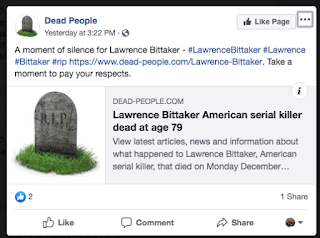 One Facebook user reports they “know (Bittaker) expressed remorse in the end.” This is not so, says true crime author Laura Brand, an expert on serial killers who has kept in constant touch with Lawrence Bittaker for the last six years. “Bittaker had no remorse for anything he did. Ever.” She has been working with Bittaker on locating the bodies of two missing victims, bodies that have never been recovered, hoping to bring closure to families. “There was no emotion when he talked about what he had done.”Perhaps those mourning Lawrence Bittaker have forgotten about the five innocent murdered girls and the girl’s loved ones. Maybe the mourners have never been victims of crime. The hell that Bittaker unleashed during his life deserves not one moment of respect. I hope no one ever has to go through what these young victims endured. I hope no one ever has to be a family member or friend of someone who met a Bittaker or a Norris. And I sure as hell hope those who think Bittaker deserves any respect, even in death, will take a long look in the mirror and ask themselves, “What if it were my child on that audiotape in that courtroom?”
One Facebook user reports they “know (Bittaker) expressed remorse in the end.” This is not so, says true crime author Laura Brand, an expert on serial killers who has kept in constant touch with Lawrence Bittaker for the last six years. “Bittaker had no remorse for anything he did. Ever.” She has been working with Bittaker on locating the bodies of two missing victims, bodies that have never been recovered, hoping to bring closure to families. “There was no emotion when he talked about what he had done.”Perhaps those mourning Lawrence Bittaker have forgotten about the five innocent murdered girls and the girl’s loved ones. Maybe the mourners have never been victims of crime. The hell that Bittaker unleashed during his life deserves not one moment of respect. I hope no one ever has to go through what these young victims endured. I hope no one ever has to be a family member or friend of someone who met a Bittaker or a Norris. And I sure as hell hope those who think Bittaker deserves any respect, even in death, will take a long look in the mirror and ask themselves, “What if it were my child on that audiotape in that courtroom?”Rest in peace Lucinda Lynn Schaefer, Andrea Hall, Jacqueline Gilliam, Jacqueline Leah Lamp, Shirley Lynette Ledford, and the unknown victims who we hope will be identified and laid to rest soon.
Resources include:Furio, J. (1998). The Serial Killer Letters: A Penetrating Look Inside the Minds of Murderers. Jennifer Furio, publisher.Rowley, M. (December 10, 2019) Would You Pick Up The Phone if a Serial Killer Called? HuntAKiller.com Vronsky, P. (2004). Serial Killers: The Method and Madness of Monsters. Berkley Books.
Published on December 17, 2019 20:00
Serial killer Garland Milam: “addicted to sucking souls out of people”
“I got addicted to sucking the souls out of people that I was killing,” Garland Milam told law enforcement. “And I’m going to do it again if I don’t get the death penalty.”Garland Ray Milam traveled cross-country as an adult, continually fighting an urge. Sometimes he took drugs, hoping it would stop or at least temporarily control the impulse. Garland Milam had an urge to murder. He did fine in stopping the compulsion to take a life whenever it came upon him, flooding his senses like an addiction.
 Serial killer Garland Milam (Nashville PD)But in July 2005 in Nashville, Tennessee, Milam lost control, and two men lost their lives.Milam, born in April 1965, was removed by state social services from his mother’s home at the age of ten. He would later remember his mother as a biker who worked as a topless dancer, an alcoholic who introduced him to crystal meth. The boy went to go live with his aunt. As an adult, he would be diagnosed with Post Traumatic Stress Disorder; he blamed it on abuse suffered at her hand. She would counter he was “an uncontrollable child.” An angry child, he says, “I was taking a lot of the rage and anger that I had out on small animals.” He killed puppies and kittens by snapping the necks and smothering them. When he was a teenager, Milam struck out on his own, finding a job at a diner. He lived on a goat farm. Staying busy kept the urge to murder at bay, but when laid off from his job, the urge overtook him, and he tortured and smothered some of the baby goats. “The wandering, the traveling, and the hitchhiking – as long as I was constantly moving, it seemed like I evaded the desire to kill.” When the urge bubbled to the surface, he turned to marijuana and crack cocaine to curb the desire. In 1995, Milam’s brother Tommy found him a job in Florida, but Milam didn’t stick around. He would say he began having impulses to kill Tommy, so he ran, hitting the road again. The desire to kill “was an internal beast.” In December 2005. Garland Milam ended up in Nashville, Tennessee. It would prove fatal for two men. In Antioch, located southeast of Nashville, Milam set up a camp spot near other homeless men in an embankment about 300 yards behind a strip mall. Police would later express surprise at how clean his camp was, and how clean Milam kept himself. Milam would make friends with Tim McCoy and Johnny Paul Davis, both 48, who also set up camp in the woods. Then came the day where Milam would earn the mane “Soul Sucker” from the Nashville media.One story was Garland Milam asked Tim McCoy to chip in money together to purchase alcohol; McCoy agreed then decided he was not going to put in his money. An argument ensued, and Milam could not stop the urge this time: he murdered Tim McCoy by dropping a money belt around the man’s neck and pulling it tight. Milam told others that McCoy kicked Milam “a good one – almost broke my leg.” Milam then reported, “He quit moving, and his soul rode the last breath out of his body, and I – ffffpppp – inhaled it.” Then he placed the body into a tent and set it on fire, setting it up so it would appear to be an accident. He even met with a detective as a witness to the fire: he had been with McCoy the night before, Milam told the detective, and that morning had come upon the still smoldering fire. The next day, Milam told Davis the details of how he murdered McCoy. Davis asked, “Why did you tell me this?” Milam replied, “Well, because now I have to kill you. I am going to give you a five-minute head start to get out of my camp before I kill you.” But Davis was so drunk he could not run. Milam told Davis as he strangled him, “I’m doing this to put you out of your misery.” He tried but did not manage to “suck the soul” of Davis. “I think I missed it.”Milam equated killing with getting high, but it was better than crystal meth: he reported there is tingling all over the body while committing murder, a rush that makes him lose control, including his bowels. He said, “I didn’t like a messy killing.”Milam turned himself in, walking to a nearby grocery store. He told a store employee he was turning himself in for murder, to please call the police.Milam would later confess to killing a Tucson, Arizona man with a machete, and severely beating a Topeka, Kansas man with a ball bat. On January 24, 2007, Milam pled guilty to the murders of Tim McCoy and Johnny Paul Davis. He requested the death penalty. “I know that I’m a monster,” he told the judge. Instead, he received two 51-year sentences to run consecutively. Garland Ray Milam is incarcerated in the Tennessee Department of Corrections in Clifton. He has never expressed remorse about his crimes.
Serial killer Garland Milam (Nashville PD)But in July 2005 in Nashville, Tennessee, Milam lost control, and two men lost their lives.Milam, born in April 1965, was removed by state social services from his mother’s home at the age of ten. He would later remember his mother as a biker who worked as a topless dancer, an alcoholic who introduced him to crystal meth. The boy went to go live with his aunt. As an adult, he would be diagnosed with Post Traumatic Stress Disorder; he blamed it on abuse suffered at her hand. She would counter he was “an uncontrollable child.” An angry child, he says, “I was taking a lot of the rage and anger that I had out on small animals.” He killed puppies and kittens by snapping the necks and smothering them. When he was a teenager, Milam struck out on his own, finding a job at a diner. He lived on a goat farm. Staying busy kept the urge to murder at bay, but when laid off from his job, the urge overtook him, and he tortured and smothered some of the baby goats. “The wandering, the traveling, and the hitchhiking – as long as I was constantly moving, it seemed like I evaded the desire to kill.” When the urge bubbled to the surface, he turned to marijuana and crack cocaine to curb the desire. In 1995, Milam’s brother Tommy found him a job in Florida, but Milam didn’t stick around. He would say he began having impulses to kill Tommy, so he ran, hitting the road again. The desire to kill “was an internal beast.” In December 2005. Garland Milam ended up in Nashville, Tennessee. It would prove fatal for two men. In Antioch, located southeast of Nashville, Milam set up a camp spot near other homeless men in an embankment about 300 yards behind a strip mall. Police would later express surprise at how clean his camp was, and how clean Milam kept himself. Milam would make friends with Tim McCoy and Johnny Paul Davis, both 48, who also set up camp in the woods. Then came the day where Milam would earn the mane “Soul Sucker” from the Nashville media.One story was Garland Milam asked Tim McCoy to chip in money together to purchase alcohol; McCoy agreed then decided he was not going to put in his money. An argument ensued, and Milam could not stop the urge this time: he murdered Tim McCoy by dropping a money belt around the man’s neck and pulling it tight. Milam told others that McCoy kicked Milam “a good one – almost broke my leg.” Milam then reported, “He quit moving, and his soul rode the last breath out of his body, and I – ffffpppp – inhaled it.” Then he placed the body into a tent and set it on fire, setting it up so it would appear to be an accident. He even met with a detective as a witness to the fire: he had been with McCoy the night before, Milam told the detective, and that morning had come upon the still smoldering fire. The next day, Milam told Davis the details of how he murdered McCoy. Davis asked, “Why did you tell me this?” Milam replied, “Well, because now I have to kill you. I am going to give you a five-minute head start to get out of my camp before I kill you.” But Davis was so drunk he could not run. Milam told Davis as he strangled him, “I’m doing this to put you out of your misery.” He tried but did not manage to “suck the soul” of Davis. “I think I missed it.”Milam equated killing with getting high, but it was better than crystal meth: he reported there is tingling all over the body while committing murder, a rush that makes him lose control, including his bowels. He said, “I didn’t like a messy killing.”Milam turned himself in, walking to a nearby grocery store. He told a store employee he was turning himself in for murder, to please call the police.Milam would later confess to killing a Tucson, Arizona man with a machete, and severely beating a Topeka, Kansas man with a ball bat. On January 24, 2007, Milam pled guilty to the murders of Tim McCoy and Johnny Paul Davis. He requested the death penalty. “I know that I’m a monster,” he told the judge. Instead, he received two 51-year sentences to run consecutively. Garland Ray Milam is incarcerated in the Tennessee Department of Corrections in Clifton. He has never expressed remorse about his crimes.ResourcesFly, C. (July 27, 2005) “Drifter Charged With two Homeless Murders in Nashville.” Southern Standard. McMinnville, TN.Drifter Says He Tried To Outrun Need To Kill. (September 29, 2005) The Tennessean. Homeless Killer Reveals Details of Murders. (January 25, 2007) WSMV.comHomeless Man Strangled With Leash (August 16, 2005). Source not cited, appears on Murderpedia.org. https://murderpedia.org/male.M/m/mila... Admits To Committing More Than Two Murders. (August 16, 2005). News Channel 5.com. Posted on Canadian Coalition Against the Death Penalty. http://ccadp.proboards.com/thread/155...
Published on December 17, 2019 05:15
December 16, 2019
This cannibal walks the street free: "any woman who wants to kill me to step forward"
Born in 1949, Japan’s Issei Sagawa has everything his wealthy family could provide for him. He is also highly intelligent, receiving his Ph.D. in literature at the age of 32 while studying in France. And he is a cannibal.
Issei Sagawa was a premature baby, small enough to fit in his father’s hand. He was a skinny, weak child and in first grade, he observed “the quivering meat on a male classmate's thighs and I suddenly thought, ‘Mmm, that looks delicious.’" From this point on Sagawa obsessed over eating human flesh. He also self-reports other fetishes, including bestiality with his dog as a child. As he grew older, he became obsessed with tall, beautiful Western women. Sagawa grew to be less than five feet tall and, in his opinion, not particularly handsome or desirable; he believes this is why he is attracted to this type of woman.
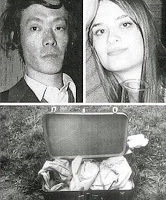 Issei Sagawa, Renee Hartevelt, and
Issei Sagawa, Renee Hartevelt, and one of the suitcasesSagawa’s obsession was initially just to bite, “to gnaw on their flesh.” He recognizes it as part of a sexual act and not as something affiliated with hunger. He also learned if he did not masturbate often, the urge to bite women, to "gnaw" them, would become stronger and stronger. He explains that cannibalism is an extension of wanting to be next to a woman, an extension of liking someone, wanting to see her, smell and kiss her. “The desire to (kiss) is based on primal urges.”
When he was 23 years old, in Tokyo, Issei Sagawa watched a tall German woman walking home. He broke into her apartment and, as she slept, sliced off a piece of her skin to consume. She awoke and managed to escape. He was caught and charged with attempted rape. Cannibalism was not suspected then, because Sagawa kept his secret. At 32, Sagawa moved to France to earn his Ph.D. in literature at the Sorbonne. He would pick up prostitutes and try to shoot them from behind so he could consume their flesh, but could not make himself pull the trigger. Part of the reason was the realization that he would ruin his life by committing murder. He would later admit to picking up “hundreds” of prostitutes and fail in his attempts to kill, and that killing them became more about a “ritual” than about eating their flesh. The women never suspected there was a gun being pointed at their backs, never knew how close they were to dying.While at the university he met a Dutch woman seven years his junior named Renee Hartevelt. They were good friends and study partners. Sagawa had invited Renee to his house numerous times, and she never realized he had pointed the gun to the back of her head, just as he had done with the prostitutes. Finally, on the night of June 9, 1981, Issei Sagawa decided he had to murder Renee Hartevelt and eat her flesh. She came over to his house as planned. When she turned her back to him he snuck up behind her, raised the gun to
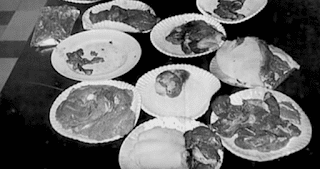 Police found Issei Sagawa had placed parts of
Police found Issei Sagawa had placed parts of Renee Hartevelt's organs on platesher head, and pulled the trigger. It misfired, and he quickly put the gun away. Renee, unaware of the gun, happily agreed to return in two nights “to work on a poetry assignment.” Again, Sagawa waited for Renee to turn her back to him; he crept up behind her, raised the gun to her head, and pulled the trigger. He would later say he regretted killing her and wished he had asked her if he could just taste her because he preferred eating living flesh and because he had lost a good friend by murdering her. It was best to kill a stranger, someone he had not personalized.Sagawa performed necrophilia with the corpse, and then ate the sex organs of the body, the tongue, breasts, face, and the neck. He tried to eat through the buttocks but found them too thick to chew through. He kept the corpse for a day, which made the meat “taste better.” The soles of the feet smelled bad, and because the victim was on her period, there were other body parts that smelled. “If you really want to feast, you should eat the thighs,” he would tell a reporter in 2018. He packaged and froze some of the organs and body parts, leaving the head, legs, and torso. He stuffed these body parts into two suitcases and hailed a cab. The plan was to drop the suitcases into the Bois de Boulogne Lake but witnesses observed him and notified police. The suitcases were dripping blood, and Sagawa told the officers, “I killed her to eat her flesh.”
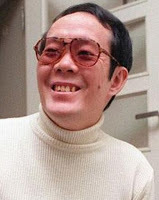 Issei Sagawa circa 2009Sagawa’s wealthy family bought him the best defense lawyer. Police held him for two years in France and he was declared legally insane; therefore, he was exempt from prosecution. The French court documents were sealed so they were not available to Japanese courts. Sagawa was deported to Japan. Back in his home country, Sagawa was held in a mental institution until professionals declared him sane; thus, he could sign himself out of the institution. This he did in August 1986, and Issei Sagawa now walks the streets of Japan. Sagawa’s fetish goes beyond cannibalism. He has explained a female friend gave him bottles of her urine and saliva to consume. After the woman gave birth, however, Sagawa became turned off. He began seeing her as a mother figure and he claims the urine became odiferous.Does he still have the same urge to eat live human beings? In 2018 he asked Vice Reporter Tomokazu Kosuga, “Can you please call for people who would willingly be eaten by me in your magazine?” He also requested “any woman who wants to kill me to step forward” saying his dream would be to drown in female saliva. Issei Sagawa remains in Japan and has worked as an author, a commentator, an actor, and has been featured in documentaries. He is in poor health and is cared for by a brother who has admitted perverse sexual fantasies of his own. Sagawa's new dream is to die at the hands of another cannibal.
Issei Sagawa circa 2009Sagawa’s wealthy family bought him the best defense lawyer. Police held him for two years in France and he was declared legally insane; therefore, he was exempt from prosecution. The French court documents were sealed so they were not available to Japanese courts. Sagawa was deported to Japan. Back in his home country, Sagawa was held in a mental institution until professionals declared him sane; thus, he could sign himself out of the institution. This he did in August 1986, and Issei Sagawa now walks the streets of Japan. Sagawa’s fetish goes beyond cannibalism. He has explained a female friend gave him bottles of her urine and saliva to consume. After the woman gave birth, however, Sagawa became turned off. He began seeing her as a mother figure and he claims the urine became odiferous.Does he still have the same urge to eat live human beings? In 2018 he asked Vice Reporter Tomokazu Kosuga, “Can you please call for people who would willingly be eaten by me in your magazine?” He also requested “any woman who wants to kill me to step forward” saying his dream would be to drown in female saliva. Issei Sagawa remains in Japan and has worked as an author, a commentator, an actor, and has been featured in documentaries. He is in poor health and is cared for by a brother who has admitted perverse sexual fantasies of his own. Sagawa's new dream is to die at the hands of another cannibal. Resources“Caniba” (October 2018). A Norte Prods., Sensory Ethnography Lab production in association with Cineventure 3. (International sales: Elle Driver, Paris.) Producers: Valentina Novati, Verena Paravel, Lucien Castaing-Taylor.Greenfest, Sara (April 17, 2018). ‘Issei Sagawa, the Japanese cannibal who still walks free.” Insider. https://www.insider.com/strange-murde..., Tomokazu (January 1, 2009). “Who's Hungry?” Vice. https://www.vice.com/en_us/article/7b..., Steven (September 20, 2007). "Issei Sagawa: Celebrity Cannibal". New Criminologist, the On-line Journal of Criminology. New Criminologist. Serena, Katie (October 26, 2018). “Cannibal Killer Issei Sagawa Is Walking Free And Plans To Eat Humans Again.” ATI. https://allthatsinteresting.com/issei...
Published on December 16, 2019 05:00
December 2, 2019
True Crime’s Darling: Bonnie Parker
On May 21, 1934, at 9:15 am, six lawmen lying in wait along a dusty road near Gibsland, Louisiana opened fire on a vehicle they had been watching for, drilling dozens of holes through the Ford V8 sedan and the man and woman inside. Their ears still ringing from the fusillade, covered in insect bites and scratches from their overnight stay in the woodsy hiding spot, the officers had no idea they cast a stone into a pond that ripples to this day. They had written a very large exclamation point at the end of a notable chapter in American criminal history, and ensured a lurid end to a wild story that has garnered a bevy of followers, the number of which has steadily increased since. The woman lying dead in the bullet-riddled sedan, who along with her partner had died a death so violent and legendary that even Hollywood couldn’t have written a more spectacular ending was true crime’s darling, Bonnie Parker.
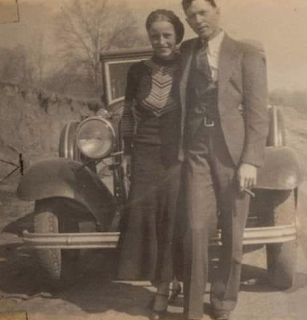 Bonnie Parker with Clyde BarrowThe occupants of the Ford V8 and the target of the officers were Bonnie Elizabeth Parker and her lover, Clyde Chestnut Barrow. From 1932 up to that day in May of 1924 when they were killed the duo, in the company of a changing assortment of “gang” members had committed crimes across at least four states; their crimes made for lurid headlines and gave people desperate for news other than the impact of the Depression a colorful story and a guilty pleasure as they followed the crime spree of the Barrow Gang in their local newspapers. Long after their gruesome deaths, the young couple remain some of the top stars of the crime annals. Movies, documentaries, books, and even a musical have documented their lives. “Bonnie & Clyde Trade Days & RV Park” is located near the couple’s murder site. An annual “Bonnie & Clyde Festival” is held in Gibsland featuring reenactments of the ambush, period costumes and cars, and museums featuring relics and information on the young gangsters. Bonnie’s headstone and
Bonnie Parker with Clyde BarrowThe occupants of the Ford V8 and the target of the officers were Bonnie Elizabeth Parker and her lover, Clyde Chestnut Barrow. From 1932 up to that day in May of 1924 when they were killed the duo, in the company of a changing assortment of “gang” members had committed crimes across at least four states; their crimes made for lurid headlines and gave people desperate for news other than the impact of the Depression a colorful story and a guilty pleasure as they followed the crime spree of the Barrow Gang in their local newspapers. Long after their gruesome deaths, the young couple remain some of the top stars of the crime annals. Movies, documentaries, books, and even a musical have documented their lives. “Bonnie & Clyde Trade Days & RV Park” is located near the couple’s murder site. An annual “Bonnie & Clyde Festival” is held in Gibsland featuring reenactments of the ambush, period costumes and cars, and museums featuring relics and information on the young gangsters. Bonnie’s headstone and
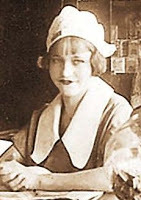 Parker before she met Barrowthe marker identifying their death site has been chipped away by souvenir hunters. After nearly a century, their two-year tally of murders, bank robberies and harrowing escapes from the law is still the stuff of legend and fascination.
Parker before she met Barrowthe marker identifying their death site has been chipped away by souvenir hunters. After nearly a century, their two-year tally of murders, bank robberies and harrowing escapes from the law is still the stuff of legend and fascination.
Bonnie Parker wrote maudlin poetry; her most famous composition was "The Trail's End" later retitled "The Story of Bonnie and Clyde.” This typed, single piece of paper is on display at the Pigeon Forge, Tennessee Crime Museum, in an exhibit featuring several artifacts connected with the infamous duo. Collectors pay exorbitant sums of money for a weapon, a thread pulled from their clothing, or any relic touched by the duo. Several artifacts sold for a total of $1.1 million in a 2012 auction; the gun found strapped to dead Bonnie’s hip gaveled down at $264,000 and Clyde’s pistol went for $240,000. Clyde 's pocket watch sold for $36,000, and a silver dollar found on his dead body sold for $32,000. Their death car (worth an estimated $5 million) and Clyde’s death shirt are on display in a Primm, Nevada casino behind thick glass near the cashier cage. Why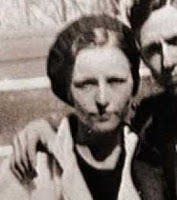 Parker after being on the runall of this interest and investment in artifacts left behind by a petty gang who killed law enforcement officers and innocent people?
Parker after being on the runall of this interest and investment in artifacts left behind by a petty gang who killed law enforcement officers and innocent people?
Depending on which historian or biographer you ask, Bonnie Parker was either a sweet, good girl gone wrong for love or a nasty, drunken, chain-smoking she-devil looking for adventure and quick riches at the mouth of a gun. Pre-crime spree photographs show a sweet, cute little girl, and a pretty, petite young lady. Photographs seized by law enforcement officers after shoot-outs reveal how alcohol and the stresses of living on the run eroded her beauty. The last few photos show a ragged-looking woman who had to be carried after a car crash left her burned, disfigured and unable to walk. She looks as if life had caught up with her and winnowed her down; Bonnie Parker did not live to see her 24th birthday. She has been depicted as a tough, bigger-than-life character, a no-nonsense gun moll with a pistol in one hand and a cigar in the other. Yet Bonnie was tiny, weighing less than 100 pounds and standing just shy of five feet tall. Witnesses said she did not seem to be concerned over dying. Her language was salty and her manners violent and sometimes crude and yet she craved news from home and word of her beloved family. Historians continually argue as to the veracity of reports of her picking up a gun to fire at anyone, her criminal history before meeting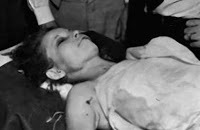 Parker in deathClyde and her depth of involvement in gang activities.
Parker in deathClyde and her depth of involvement in gang activities.
Perhaps it is the love story that intrigues people. There was no doubt, from the time they met until the moment they died that Bonnie and Clyde loved one another. Bonnie refused to give up and go home or leave the criminal life every time the subject came up if it meant leaving Clyde, alone, wanted and on the run. She knew she would not live long and she elected to spend every moment she had left with Clyde. Maybe it is the popular folk impression that they were modern-day Robin Hoods stealing from the big corporate banks that elevated their crimes and flight to mythical status. In truth, the majority of their robberies were from tiny, family-owned businesses and their withdrawals facilitated at gunpoint hurt local depositors far more often than rich bankers and wealthy stockholders. Their escapades, documented in newspapers across the country kept people’s minds off their desperate living conditions during the Great Depression. Lurid crime stories sell papers, and none more than the adventures of Bonnie and Clyde. Bonnie herself was well aware of their notoriety when she wrote, A newsboy once said to his buddy "I wish old Clyde would get jumped; In these awful hard times We'd make a few dimes If five or six cops would get bumped."
 Bonnie Parker with Clyde BarrowThe occupants of the Ford V8 and the target of the officers were Bonnie Elizabeth Parker and her lover, Clyde Chestnut Barrow. From 1932 up to that day in May of 1924 when they were killed the duo, in the company of a changing assortment of “gang” members had committed crimes across at least four states; their crimes made for lurid headlines and gave people desperate for news other than the impact of the Depression a colorful story and a guilty pleasure as they followed the crime spree of the Barrow Gang in their local newspapers. Long after their gruesome deaths, the young couple remain some of the top stars of the crime annals. Movies, documentaries, books, and even a musical have documented their lives. “Bonnie & Clyde Trade Days & RV Park” is located near the couple’s murder site. An annual “Bonnie & Clyde Festival” is held in Gibsland featuring reenactments of the ambush, period costumes and cars, and museums featuring relics and information on the young gangsters. Bonnie’s headstone and
Bonnie Parker with Clyde BarrowThe occupants of the Ford V8 and the target of the officers were Bonnie Elizabeth Parker and her lover, Clyde Chestnut Barrow. From 1932 up to that day in May of 1924 when they were killed the duo, in the company of a changing assortment of “gang” members had committed crimes across at least four states; their crimes made for lurid headlines and gave people desperate for news other than the impact of the Depression a colorful story and a guilty pleasure as they followed the crime spree of the Barrow Gang in their local newspapers. Long after their gruesome deaths, the young couple remain some of the top stars of the crime annals. Movies, documentaries, books, and even a musical have documented their lives. “Bonnie & Clyde Trade Days & RV Park” is located near the couple’s murder site. An annual “Bonnie & Clyde Festival” is held in Gibsland featuring reenactments of the ambush, period costumes and cars, and museums featuring relics and information on the young gangsters. Bonnie’s headstone and Parker before she met Barrowthe marker identifying their death site has been chipped away by souvenir hunters. After nearly a century, their two-year tally of murders, bank robberies and harrowing escapes from the law is still the stuff of legend and fascination.
Parker before she met Barrowthe marker identifying their death site has been chipped away by souvenir hunters. After nearly a century, their two-year tally of murders, bank robberies and harrowing escapes from the law is still the stuff of legend and fascination.Bonnie Parker wrote maudlin poetry; her most famous composition was "The Trail's End" later retitled "The Story of Bonnie and Clyde.” This typed, single piece of paper is on display at the Pigeon Forge, Tennessee Crime Museum, in an exhibit featuring several artifacts connected with the infamous duo. Collectors pay exorbitant sums of money for a weapon, a thread pulled from their clothing, or any relic touched by the duo. Several artifacts sold for a total of $1.1 million in a 2012 auction; the gun found strapped to dead Bonnie’s hip gaveled down at $264,000 and Clyde’s pistol went for $240,000. Clyde 's pocket watch sold for $36,000, and a silver dollar found on his dead body sold for $32,000. Their death car (worth an estimated $5 million) and Clyde’s death shirt are on display in a Primm, Nevada casino behind thick glass near the cashier cage. Why
 Parker after being on the runall of this interest and investment in artifacts left behind by a petty gang who killed law enforcement officers and innocent people?
Parker after being on the runall of this interest and investment in artifacts left behind by a petty gang who killed law enforcement officers and innocent people?Depending on which historian or biographer you ask, Bonnie Parker was either a sweet, good girl gone wrong for love or a nasty, drunken, chain-smoking she-devil looking for adventure and quick riches at the mouth of a gun. Pre-crime spree photographs show a sweet, cute little girl, and a pretty, petite young lady. Photographs seized by law enforcement officers after shoot-outs reveal how alcohol and the stresses of living on the run eroded her beauty. The last few photos show a ragged-looking woman who had to be carried after a car crash left her burned, disfigured and unable to walk. She looks as if life had caught up with her and winnowed her down; Bonnie Parker did not live to see her 24th birthday. She has been depicted as a tough, bigger-than-life character, a no-nonsense gun moll with a pistol in one hand and a cigar in the other. Yet Bonnie was tiny, weighing less than 100 pounds and standing just shy of five feet tall. Witnesses said she did not seem to be concerned over dying. Her language was salty and her manners violent and sometimes crude and yet she craved news from home and word of her beloved family. Historians continually argue as to the veracity of reports of her picking up a gun to fire at anyone, her criminal history before meeting
 Parker in deathClyde and her depth of involvement in gang activities.
Parker in deathClyde and her depth of involvement in gang activities.Perhaps it is the love story that intrigues people. There was no doubt, from the time they met until the moment they died that Bonnie and Clyde loved one another. Bonnie refused to give up and go home or leave the criminal life every time the subject came up if it meant leaving Clyde, alone, wanted and on the run. She knew she would not live long and she elected to spend every moment she had left with Clyde. Maybe it is the popular folk impression that they were modern-day Robin Hoods stealing from the big corporate banks that elevated their crimes and flight to mythical status. In truth, the majority of their robberies were from tiny, family-owned businesses and their withdrawals facilitated at gunpoint hurt local depositors far more often than rich bankers and wealthy stockholders. Their escapades, documented in newspapers across the country kept people’s minds off their desperate living conditions during the Great Depression. Lurid crime stories sell papers, and none more than the adventures of Bonnie and Clyde. Bonnie herself was well aware of their notoriety when she wrote, A newsboy once said to his buddy "I wish old Clyde would get jumped; In these awful hard times We'd make a few dimes If five or six cops would get bumped."
Published on December 02, 2019 00:00
November 26, 2019
Boy, not yet 3, murders infant sister - a case from true crime history
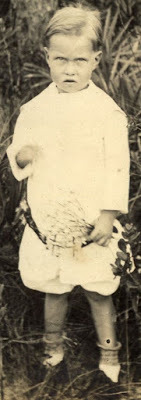 No known photo of Emmet Robinsonexists. This photo of an unknown childis used to show the dress and hairstyle of boys Emmet's age during this time period.
No known photo of Emmet Robinsonexists. This photo of an unknown childis used to show the dress and hairstyle of boys Emmet's age during this time period.Emmet did not like that he was no longer the only child in the household. His new baby sister seemed to be getting all of the attention and love once lavished on him. So Emmet Robinson bashed in the skull of his month-old sister, Gladys, in a fit of jealousy. Emmet was not yet three years old.
The October 12, 1904 edition of The Boston Globe reports that little Emmet Robinson of Nyack, New York, the son of Mr. and Mrs. Nicholas Robinson, was furious about the birth of Gladys. “He hated the sister. He ran away, hid himself … was found weeping, sobbing, choking with childish rage.” The Robinsons knew Emmet’s anger had escalated when they caught him striking little Gladys. And he was caught overturning her crib while she lay in it. “I want the baby to go away,” he had told his parents. (p.1)Emmet was two years and seven months old on a Saturday, October 8, 1904. His mother would later report how, about eight o’clock in the morning, she took a bronze statuette from the mantle to let Emmet play with it and left him in the same room with Gladys sleeping in her cradle. She told the coroner it was about five minutes later when Emmet yelled to her, “Mama, hurry; come look at baby!”Mrs. Robinson found her son standing over Gladys’s cradle with the bronze statuette, now covered in blood. She saw blood covering the baby’s head.Emmet was locked in another room and his mother ran for the doctor, Dr. C.D. Kline. But by the time Dr. Kline arrived, Gladys had died; the cause of death a fractured skull. Gladys had received six blows to the head with the statuette, which weighed a pound and a half. The coroner would later call it “a remarkable instance of infantile crime” (Jealous Brother Kills Babe).Gladys’ funeral was held the following Wednesday. Emmet was observed pulling at his mother’s skirt and his father’s sleeve as they grieved. Reporters felt the boy was still seeking attention.Dr. Kline believed, and Coroner Bittig’s inquest confirmed, Emmet was guilty of the crime. “I am convinced that the boy knew just what he was doing and that he deliberately intended” to kill his sister. Because of his age, Emmet could not be held legally responsible. According to Coroner Bittig, when he asked Emmet where his sister was, the boy laughed and said, “Baby has gone away” (Jealous Boy Kills…). Once Gladys was buried the Robinson family no longer made the news, and they faded into obscurity.
Resources:From Jealousy: Nyack, NY Boy Kills Infant Sister. (October 12, 1904) The Boston Globe. Boston: Mass. p.1.Jealous Boy Kills New Baby. (October 17, 1904). The Salt Lake Tribune. Salt Lake City, Utah. p. 11Jealous Brother Kills Babe. (October 20, 1904). The Weekly Republican. Plymouth, Indiana. p. 2
Published on November 26, 2019 20:28



